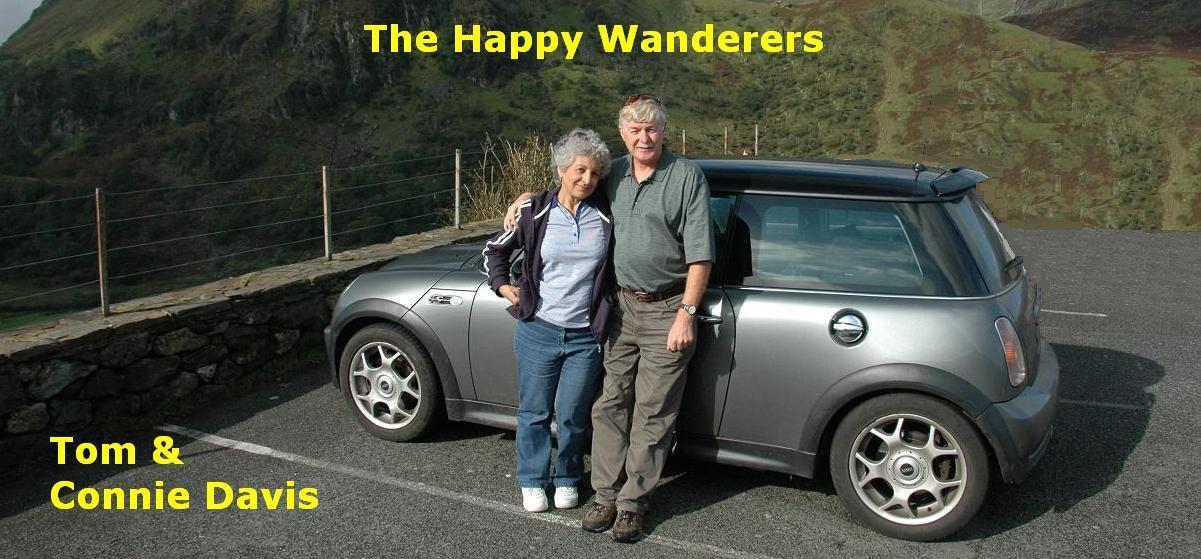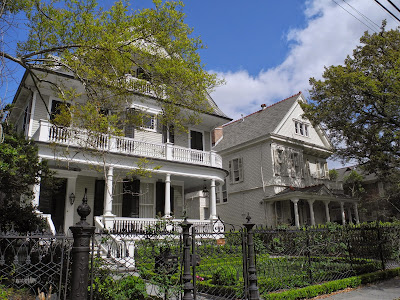I know there are those reading this humble ramble who get tired of hearing me say so, but today was just a totally awesome day and one of the best we've had. We were treated to both history and garden esthetics today and you just can't get any better than that.
Last night, you will remember, we camped about 90 miles west of Tallahassee in the tiny hamlet of Bonifay. There, we were blessed with a nearly level site, great views, gentle temperatures, and completely genial park employees. The WiFi was, as is so often true, nearly non-functional. But other than that, everything was perfect. Tonight, here in Perry, Florida, there's only about six of us in the whole camp and both Concetta and I have been able to log on without difficulty.
This morning's 90-mile ride into Tallahassee was accompanied by our current exciting book on CD, "The English Assassin," by Daniel Silva, and so the time went by in a flash. Interstate 10 is a wonderful bit of pavement, is separated east and west by a huge grassy median, and our side was not very crowded at all. I was able to put the RV on cruise control, sit back, and enjoy the book the whole way.
Our first stop of the day was scheduled to be the Mission at San Luis on the outskirts of Tallahassee. From our reading we had determined that we might be able to see some archeological work in progress and this is a subject in which we both are extremely interested. The GPS had no trouble finding the mission and we were soon browsing through the museum and book store and learning the background for this nearly three-hundred-year-old site.
Once finished with the museum, we found our way to the rear exit and walked out into what was to become one of our most memorable Chautauqua-style experiences of the trip. Not really realizing what was in store, we wandered over to a huge, mound-shaped, grass-covered structure that looked like Gilligan might have stayed there once upon a time. Nothing could be further from the truth. This structure, actually covered with palm fronds, turned out to be three stories high and capable of sheltering up to two thousand people. No grass hut, this!

Once inside, we learned that a Native American tribe known as the Appalachee had constructed the original meeting house. The current meeting house was a modern reconstruction using original-style materials and was built on the original site dating to the 1700s. But these materials were not for the faint of heart. In the center of the building was a sort of Stonehenge-style circle of giant tree trunks with other giant trees tying the tops together. Further out, another circle of tree trunks and lintels were fashioned. Against this outer circle of logs the builders had leaned vertical logs, some short and some as long as thirty feet. Then much smaller limbs were tied to these "rafters" over which the palm fronds were woven. I must say I was very, very impressed. Even using a boom truck or crane, I could see where you might have trouble building this structure. Without any mechanized equipment, I don't know how the original builders did it.
While Concetta and I explored the meeting house, we encountered a Chautauqua docent who told us the whole story of the
events that would normally take place inside the meeting house three centuries ago. I'm not sure why, but I'm always surprised by the complexity of the Native American societies. Inside the meeting house, ringing the outer wall, were rack after rack where bedrolls could be laid out for visiting tribal members from afar. Coming in from the center of the meeting house, and placed in a ring, were lower racks where all the immediate members of the council would sit. On the East side of this ring sat the Chief. Opposite him, a break in the wall offered entrance to the meeting house. The entrance was kept very low, headroom wise, to force entrants to be in a bowing position as they entered. The docent told us that no weapons were allowed in the meeting house.
Our next encounter, once we left the meeting house, was a blacksmith working at his forge. Though his operation was small, the blacksmith was dressed appropriately and handled his tools with skill. We lingered for many minutes talking with the blacksmith about the making of charcoal, needed for the blacksmithing process, and the forging of tools in colonial times and before. Unlike in Nevada's old west period where charcoal kilns were erected as sort of beehive-shaped structures, in Florida they tended to dig a big hole, fill the hole with wood that they set on fire, and then cover the whole affair with dirt to await the wood turning to charcoal. Seems like a crude way of doing it, but that's what the blacksmith told us.

From the blacksmith shop we trekked further to the north and visited the stockade. Though all the buildings on the Mission property are reconstructions, they have gone to no small amount of trouble to make sure your Chautauqua experience is one you'll remember. When we got to the stockade there were two young men to help us visualize the military experience. After that, it was a Franciscan Friar who, though not quite believable enough for Concetta, turned out to be a friendly, amiable kind of guy who made a valiant effort to answer our questions and discuss the state of religious teachings in the new world at the time.
And so the day got off to a really fine start. Nothing is more fun for us than learning about history from folks who love it as much as we do. In addition, walking the beautiful mission grounds was a real treat and we captured many photographs in the process. The grounds were so peaceful that we went ahead and had our lunch right there before we started off in search of our next conquest, the Alfred B. MaClay Gardens State Park. The gardens were said to encompass some 1,184 acres of camellias, azaleas, magnolias, and dozens of other flowers and trees. It sounded just like our kind of place.

Though our route that morning from Interstate 10 to the San Luis mission was rather circuitous, I thought I could probably navigate us back the way we had come. Wrong! In short order I had planted our thirty-foot rig smack dab in the middle of a tiny residential neighborhood with roads just slightly wider than we were. For the next fifteen or twenty minutes we wandered aimlessly, more or less in what I thought was the direction of the Interstate and about the time I thought we better plug in the GPS for the next town and forget the gardens, we passed right over Interstate 10 and continued on north. Well, at least I knew where it was now.
Grabbing the next right so I could parallel the Interstate long enough to find an on-ramp, I had Concetta plug in the MaClay Garden address just to see if it was close. Wonders, of course, don't ever cease, and the Garden property was about a half mile from us. The GPS did attempt to have some fun at our expense and asked us to turn right instead of the required left into the gardens as we approached. This necessitated me performing one of my famous U-turns off a six lane highway in a thirty-foot rig without getting t-boned, but it worked and we were soon rolling down the entrance drive and right into heaven.

Traffic was pretty light at the MaClay gardens, at first I thought it was just us and two women in the whole 1100 some odd acres. Later we would discover others, but it didn't seem to matter as there was more than enough paradise for all of us. We found just masses of flowers everywhere, punctuated by huge old trees dripping Spanish moss, and incredible vistas of lakes and ponds. Although there is an orderly brick path that meanders through the park, you don't have to stay on the path, but can take off in any direction you want following grassy or dirt paths that wander in all directions. At one point, as I was bushwhacking around looking for good photographic vantage points, I emerged from a copse of bushes to find a startled couple standing there staring at me. Thinking fast I said, "Doctor Livingston, I presume?" Which sent them off in gales of laughter. Great fun indeed!
You could really take a picnic lunch and spend all day at the MaClay garden and not regret the time spent at all. But the sun was dropping lower and lower in the sky and we just had to get on the road. Bidding farewell to the Gardens about 3:00 p.m., we rolled south until we found the Interstate, set our course east and kept on the lookout for highway 19 which promised to send us off in a southerly plunge into the peninsular part of the state of Florida.
Once we found highway 19 we were in clover. The road was not very busy, the passing scenery was tranquil and rural, and all we had to do by the end of the day was find the tiny hamlet of Perry where there promised to be a KOA just waiting for the Happy Wanderers.
So it was, that by 4:00 p.m. or so, I was standing in front of a pretty southern girl at the KOA camp check-in desk trying to fathom what she was telling me. Believe me, I wasn't getting much of it as her southern drawl was as thick as maple syrup. But it wasn't until I asked if she had WiFi and she said something that sounded like d'vass that I was completely thrown. I opened my mouth to speak, but nothing came out except "ah.........." She said again, "hominy d'vass?" I kept repeating the word d'vass to myself, but I just wasn't getting it until suddenly I realized that she was saying "device." How many devices did I have? "Oh, two," I said, and she smiled indicating that I had answered the question appropriately.

Now we're sitting in the loveliest of camps, a little heavy on the bug population as you might expect, and using the most wonderful WiFi on my d'vass that I have yet encountered. I think it's because there are so few campers here that there doesn't happen to be anyone streaming old Gomer Pyle episodes to drag down the bandwidth. But whatever the reason, I'm going with it. I'd stay right here for the rest of the vacation if WiFi was all I cared about, but fortunately, tomorrow we're headed further south toward the city of St. Petersburg. On the way we're supposed to drive right by a botanical garden so stay tuned for more fun adventures. Obviously, this heaven we've found has a lot more rooms to explore.







































